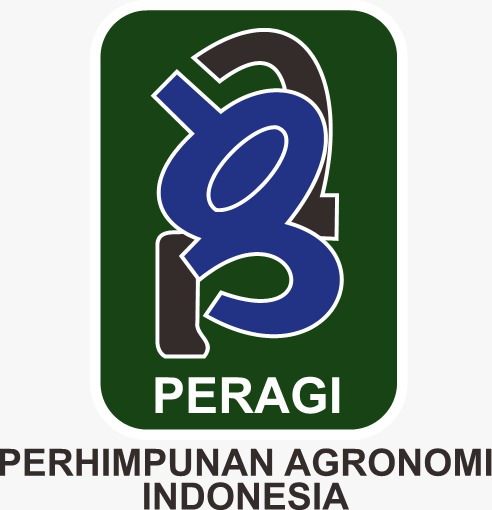Growth and Production Character Response of Kuantan Singingi Local Rice Mutants Resulting from Gamma Irradiation
Abstract
Rice (Oryza sativa L.) is a crucial crop with significant importance in various regions. In Riau, specifically in Kuantan Singingi Regency, it ranks as the fourth largest area for rice production, showcasing numerous local rice varieties with substantial development potential. This study aimed to generate mutants exhibiting early maturity and reduced plant height through gamma-ray induced mutations. A non-factorial Randomized Block Design (RAK) was employed, with the primary factor being the irradiation dose: R0 served as the control group without radiation, while the experimental group received an irradiation dose of 300 Gy, determined to be effective in prior research. Each treatment was replicated five times, utilizing a total of 600 plants per treatment. The findings indicated that rice plants subjected to 300 Gy irradiation exhibited shorter heights compared to those in the control group. Additionally, the stem circumference of plants irradiated with 300 Gy was significantly greater than that of the non-irradiated plants. Furthermore, the number of productive tillers was higher in the 300 Gy group compared to the control. However, the harvest age for rice plants exposed to 300 Gy was extended relative to those without radiation. Conversely, the length of the flag leaf in rice plants irradiated at 300 Gy was shorter than that of the control group. There remains a considerable need for data on the desired characteristics of rice mutants to facilitate advanced breeding efforts.
Downloads
References
Afdila, D., Ezward, C., & Haitami, A. (2021). Karakterisasi tinggi tanaman, umur panen, jumlah anakkan, dan berat panen pada 12 genotipe padi lokal Kabupaten Kuantan Singingi. Sain Agro, 6(1), 1–9. http://www.tjyybjb.ac.cn/CN/article/downloadArticleFile.do?attachType=PDF&id=9987
Badan Pusat Statistik. (2023). Luas panen dan produksi padi di Indonesia 2023 (angka sementara). Badan Pusat Statistik, 2023(68), 1–8. https://www.bps.go.id/pressrelease/2023/10/16/2037/luas-panen-dan-produksi-padi-di-indonesia-2023--angka-sementara-.html#:~:text=Produksi beras pada 2023 untuk,sebesar 31%2C54 juta ton.
Boceng, A., Haris, A., & Tjoneng, A. (2017). Karakter mutan padi lokal Ase Banda hasil iradiasi sinar gamma. Agrokompleks, 16(1), 42–45.
BPS Riau. (2022). Luas panen dan produksi padi di Provinsi Riau 2022 (angka sementara). BPS, 2023(21), 1–20.
Ezward, C., Indrawanis, E., Haitami, A., & Wahyudi. (2020). Penampakan karakter agronomi pada 26 genotipe padi lokal Kabupaten Kuantan Singingi. Sain Agroo, 5(2).
Ezward, C., Suliansyah, I., Rozen, N., & Dwipa, I. (2022). Resistance of local rice genotypes against brown planthopper pest in Kuantan Singingi Regency. Juatika, 4(1), 166–176.
Kadir, A., Jahuddin, R., Pratama, T., & Halim, N. (2022). Penampilan genotipe mutan padi gogo hasil iradiasi sinar gamma di lahan sawah pada musim tanaman kering. Agroecotech.
Mailala, J. H., Basuki, N., & Seogianto, A. (2016). Pengaruh iradiasi sinar gamma terhadap perubahan fenotipik tanaman padi gogo (Oryza sativa L.). Jurnal Produksi Tanaman, 4(7), 585–594.
Mardiyah, A., Wandira, A., & Syahril, M. (2022). Viabilitas dan heritabilitas populasi padi gogo kultivar Aarias Kuning generasi mutan-1 hasil iradiasi sinar gamma. Inovasi Penelitian, 3(2), 4827–4838.
Marlina, G., Andriani, D., Jayalaksamana, M., & Pramana, A. (2023). Potensi keragaman sumber daya genetik padi lokal di Kabupaten Kuantan Singingi, Provinsi Riau. Pangan, 32(2), 103–110.
Marlina, G., Syarif, A., Gustian, & Yusniwati. (2023). Tren penelitian pemuliaan mutasi pada tanaman padi: Analisis bibliometrik. Agrotekma Jurnal Agroteknologi dan Ilmu Pertanian, 7(2), 94–104. https://doi.org/10.31289/agr.v7i2.9716
Marlina, G., Syarif, A., Gustian, & Yusniwati. (2024). Orientation of effective irradiation dosage in local genetic rice improvement (Oryza sativa L.) Kuantan Singingi District using induced mutation. Juatika, 6(1).
Mirantika, D., Nurhidayah, S., Nasrudin, N., & Rahayu, S. (2023). Pendugaan keragaman genetik dan heritabilitas mutan padi hitam (Oryza sativa L.) generasi M2 hasil iradiasi sinar gamma. Jurnal Agroteknologi, 13(2), 91. https://doi.org/10.24014/ja.v13i2.21439
Rahayu, S., V, D., & Dasumiati. (2020). Keragaan malai mutan padi generasi M1 hasil iradiasi gamma. Jurnal Ilmiah Aplikasi Isotop dan Radiasi, 16(2).
Saputra, J., Syahril, M., & Murdhiani. (2021). Keragaan dan keragaman antar populasi padi kultivar Sileso generasi mutan-1 hasil iradiasi sinar gamma pada fase vegetatif. Agrosamudra, 8(1), 34–40.
Sari, H. P., Suliansyah, I., Dwipa, I., & Hervani, D. (2023). Orientasi dosis iradiasi efektif pada perbaikan genetik padi (Oryza sativa L.) lokal Padang Pariaman melalui mutasi induksi. Jurnal Produksi Tanaman, 11(6), 408–421.
Sholikhah, N., Amalia, T. C. N., Febrianty, W., Sabila, S. R. B., Anggraini, M. A. S., Prihandono, T., & Mahmud, K. (2024). Potensi penggunaan radiasi sinar gamma pada pertumbuhan tanaman padi. OPTIKA: Jurnal Pendidikan Fisika, 8(1), 36–46. https://doi.org/10.37478/optika.v8i1.3427
Tumanggor, G. E., Iswahyudi, & Mardiyah, A. (2022). Pertumbuhan, produksi dan karakter genetik padi kultivar Sileso generasi M-2 hasil iradiasi sinar gamma. Jurnal Penelitian Agrosamudra, 9(2), 31–40. https://doi.org/10.33059/jupas.v9i2.6519
Copyright (c) 2024 Gusti Marlina, Auzar Syarif, Gustian, Gustian, Yusniwati

This work is licensed under a Creative Commons Attribution 4.0 International License.
Authors who publish with Jurnal Agronomi Tanaman Tropika (JUATIKA) agree to the following terms:
Authors retain copyright and grant the Jurnal Agronomi Tanaman Tropika (JUATIKA) right of first publication with the work simultaneously licensed under a Creative Commons Attribution License (CC BY 4.0) that allows others to share (copy and redistribute the material in any medium or format) and adapt (remix, transform, and build upon the material for any purpose, even commercially) with an acknowledgment of the work's authorship and initial publication in Jurnal Agronomi Tanaman Tropika (JUATIKA).
Authors are able to enter into separate, additional contractual arrangements for the non-exclusive distribution of the journal's published version of the work (e.g., post it to an institutional repository or publish it in a book), with an acknowledgment of its initial publication in Jurnal Agronomi Tanaman Tropika (JUATIKA). Authors are permitted and encouraged to post their work online (e.g., in institutional repositories or on their website) prior to and during the submission process, as it can lead to productive exchanges, as well as earlier and greater citation of published work.







 More Information
More Information



